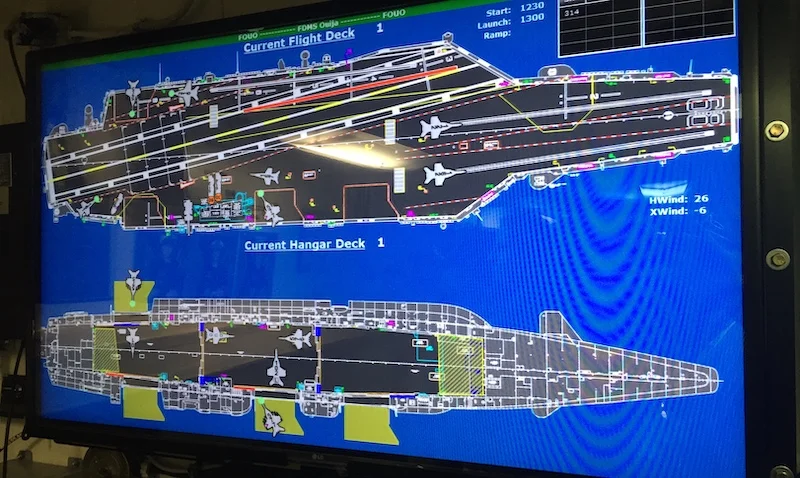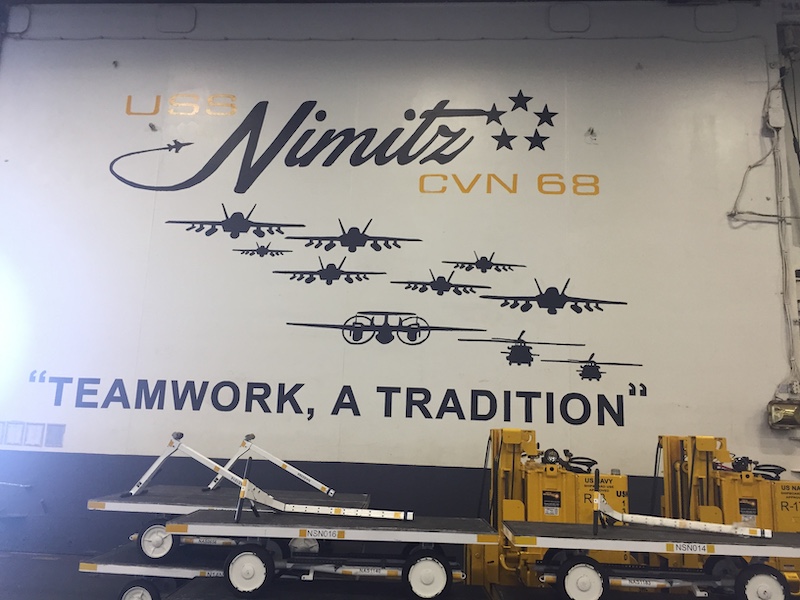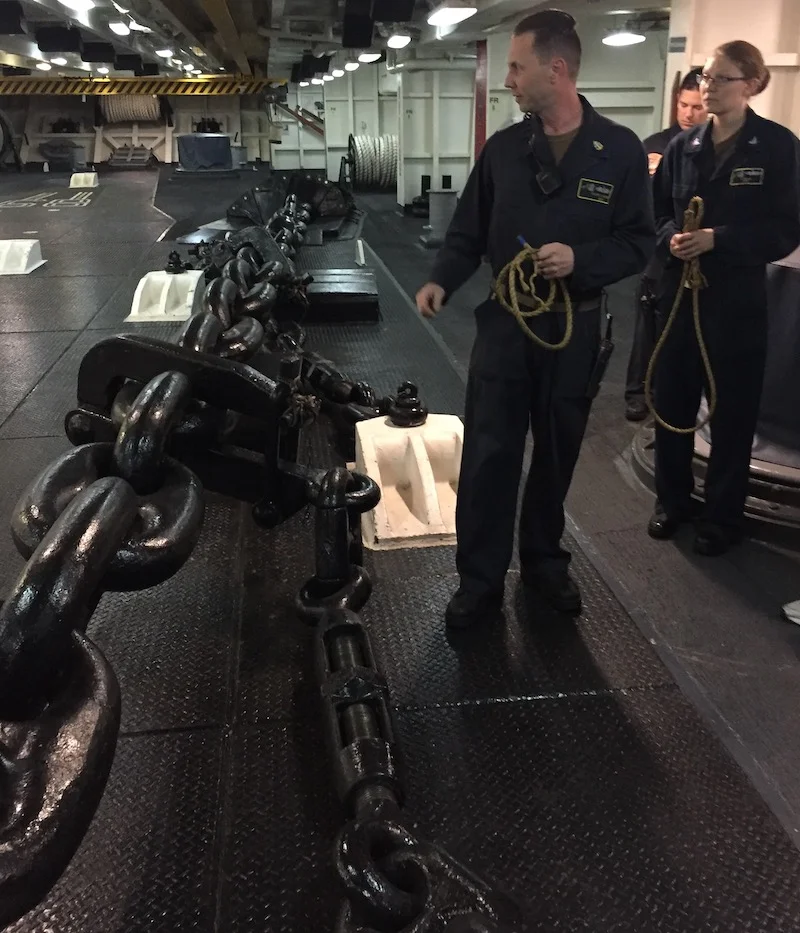What I Learned About Leadership from
2 Days “In” the Navy
Louis Patler
Prologue
In June of 2017 I received a strange email in my junk box from someone named Dennis Hall informing me that I’d been nominated to become part of the United States Navy’s “Distinguished Visitor” Program.
Glancing at it my first thoughts were “Yeah, right, how much is this going to cost me? Whose scam is this?”
Fortunately, I kept reading…and reading… and reading. The email explained in some detail that I was one of 14-16 people nationwide nominated by the Naval Air Command for this special program because of my lifetime achievements and my writings on leadership, innovation and business. If I passed the background checks, the physicals and was available on short notice, I would get to do the following:
-Fly on a C-2 jet 200 miles out to sea
-Experience a tailhook landing on a to-be-named Aircraft Carrier
-Spend two days aboard the carrier, exploring its every nook and cranny
-Eat in the mess hall, sleep in the typical sailor’s bunks, and learn the vessel’s role and history
-Freely meet and mingle with the ship’s officers and sailors
-Experience a catapult takeoff from the carrier deck and fly back to home base
And all of the above at no cost to me except to get to and from the launch site!
Too good to be true? It turns out that there are times when that adage is false: this was good, and it was true!
Confirmation of the validity of the email came when I noticed that a baseball buddy of mine, US Coast Guard Auxiliary skipper, Steve Bustin, was cc’d on the email.
As it turned out, Steve was an alumnus of this program and had nominated me. This was all very legit, and I knew that I had a chance to do something above and beyond a bucket list, something you can’t apply for, a selection process somewhat akin to the Nobel Prize or a MacArthur Genius Fellowship.
Fast forward two years, and in July 2019 off I went to the Naval Air Station in San Diego, CA to board a jet headed for the aircraft carrier USS Nimitz!
Leadership Lessons Learned
The 48 hours from take-off to the tailhook landing to the catapult return were packed with experience after experience. I had thought that the jet flight would be the highlight of the program, but it turned out that the time on ship was where the real learning took place. In those two short days “in” the Navy I gained tremendous insight into aspects of leadership that I had previously not fully understood or even considered. Here, in brief, are my Top 7 Leadership Lessons Learned:
1. The mission matters
2. Tradition supersedes culture
3. The nuclear engine and the huge anchor chains are equally important
4. “High tech” and “high touch” are collaborators
5. Hook any cable
6. A leader’s trust is earned
7. “Wear your damned cranials!”
The Mission Matters
It was clear from the moment our group was led to the C-2 jet that we were dealing with a proverbial “well-oiled machine.” Our agenda was set, minor glitches were quickly remedied, and while on ship every sailor knew their role. It was clear that all 3200 of them knew what the immediate, short-term mission was during the time of our visit: the preparation, training and certification of tailhook pilots.
From dawn till dusk, and again from 10:00pm to 2:00am, F-15 Hornet pilots attempted landings and takeoffs, at times only minutes apart. Every 7-10 minutes another jet swooped in for a landing. There were occasions that as I watched the sailors at work on the carrier deck, I felt like I was watching a fine-tuned NASCAR pit stop. Everyone knew the mission, and everyone knew their contribution to its success.
Tradition Supersedes Culture
I have researched, written about and helped to lead organizational “cultures” for several decades. Culture—e.g. “Lean” cultures, “cultures of innovation” and dozens of others --give important insights into the “what” and the “how” of a company. But culture is only part of a bigger picture.
Shortly after landing on the carrier, our group was informed that during our stay we were going to see something that few visitors ever witness, burials at sea. The ashes of 32 sailors were being honored in a time-honored ceremony. As we gathered on the hanger deck, 32 sailors, chosen at random, in dress-white uniforms, one by one heard the name of a deceased sailor and carried that sailors’ ashes to an aluminum plank overhanging the ship’s side. Following a crisp salute, the plank was tipped, and the ashes slid into the sea. Several hundred sailors stood near us and had voluntarily come to watch. These sailors did not know any of the 32, but they stood for the full 45 minutes until the final tones of “Taps” left the hangar deck. From time to time I glanced over at them, and I was touched to see tears on some of their faces, tears for 32 men and women who they did not know.
That’s when it hit me that tradition supersedes culture. Those sailors were part of an on-going tradition, and it is tradition that offers us the “why” of any group. We all need to know the culture--“the what we do” and the “how we do it” of things-- but most important is knowing “why we do it.”
The Nuclear Reactor Engine and the Huge Anchor Chains Are Equally Important
The USS Nimitz is the oldest nuclear carrier, scheduled to be taken out of service in 2025. Though its landing deck is over 1100 feet long—about the size of an 80-story building—thanks to its nuclear power plant it can reach speeds over 30 mph! You could water ski behind the USS Nimitz!
We were not allowed into the area of the ship’s nuclear engine, but we were briefed on the speed and dexterity of this huge vessel. An hour or so after the briefing, we were taken to the forward-most part of the ship and shown the anchor cables. Hundreds of feet of cast-iron anchor chains, each link 2x4 feet and weighing in at 350 lbs., were held in place by powerful hydraulics.
Upon seeing them I understood that the “yin” of the powerful nuclear engine, which moves the Nimitz into mission-critical positions, needed its matching “yang”, the anchors that held the ship steady for landings and takeoffs. They make for strange Naval bedfellows.
It reminded me that the best leaders I have come across tend to surround themselves with persons who are not like them, people with complimentary differences.
“High Tech” and “High Touch” Are Collaborators
The hangar area of the Nimitz is about 900 ft long and 250 ft wide. That’s a very large space when empty, but a very complicated “parking” area for 30+ jets, a dozen helicopter, crates and boxes and small vehicles. The technology –as well as the price tag--on the jets is staggering. So, as we entered the room where the parking logistics are worked out, I envisioned sophisticated computers, monitors and cameras.
Au contraire!
Standing behind a 3x5 foot counter, referred to as the Ouija board, were two officers. Etched on the glass countertop was the layout of the hangar and resting on the counter were little toy jets and helicopters! Made to scale, we were shown how the officers move the toy planes into parking position, fill out a slip of paper and pass it along to the parking crew! “Simple board, complex mission” we were told. And, as one of our escorting officers commented, “you can’t hack into a Ouija board!”
Hook Any Cable
Until boarding the Nimitz I had not known that there are three cables for the tailhook to engage. I had thought there was one large cable mid-ship. The cables were made of wound, steel wire about 2 inches in diameter, positioned 150 feet apart.
The on plane, tailhook apparatus is only 3-4 feet long, with an actual hook on the end that is about 6 inches wide. You can imagine the precision it takes for a pilot to get a 6-inch hook to snag a 2-inch cable at 200 mph!
My mother had a couple of one-liners that apply here: “sometimes it’s better to be useful than correct;” and “it’s not necessary to be perfect all the time.”
In that spirit, I watched pilot after pilot land. Sometimes they snagged cable #1. Or maybe #3. Or at times #2. Leaders would do well to understand this example. It didn’t much matter, the point was that a “win” came from snagging any of the three.
A Leader’s Trust Is Earned
To be the Commander of the USS Nimitz is, as you can imagine, one of the most prestigious positions in the US Navy. Commander Kevin Novak greeted us upon our arrival and offered us a light lunch in his quarters. With an easy manner and a wry sense of humor, he spoke to us about the ship’s history, his pride in the 3200 sailors on board, and the strategic importance of the carrier fleet. He handled questions easily and directly. Very comfortable in his own skin, I found myself thinking “here’s a guy I’d love to have a beverage with and hear some of his stories.”
As we were leaving our time on the ship, with his tongue firmly planted in his cheek, Commander Novak gave each of us a commemorative “Nimitz Tailhook Certificate” which read:
“Know all by these present that Lou Patler, a fearless and intrepid birdman has exhibited faultless courage, exceptional bravery, NAFOR (No Apparent Fear of Death) and intestinal fortitude in examining the entire spectrum of air approach parameters while successfully completing an arrested landing aboard USS Nimitz (CVN 68) with less than mortal injury.”
I mentioned to one of our escorts how impressed I was with the Commander’s humor and grace. “The Commander is special,” he said. “It’s not just because of his rank either. He’s earned our trust.”
“Wear your damned cranials!”
An aircraft carrier is easily one of the loudest places I have ever been. The jets thunder in and out. The waves pound the hull constantly. The metal bowels of the ship echo and amplify every sound. It is literally a deafening environment.
A carrier is also a dangerous place with large pieces of equipment always moving, the ship itself swaying, the absence of stairs and in their place ladder after ladder to get you from deck to deck.
So, the protect us from the noise, and from hitting our heads on God-knows-what, we were all given “cranials,” two-piece helmets with full protective goggles and overlapping noise canceling headsets. Any time we ventured out to the carrier deck or outside observation areas, we were told in no uncertain terms to “wear your damned cranials.” There were no exceptions.
It occurred to me that there are certain times when leaders have to make some things non-negotiable. It’s something I learned as the parent of five kids. “Tough love” may not be popular, but you know from experience that it is important.
Epilogue
The officers and crew of the USS Nimitz offered me the experience of a lifetime. In this blog I revisited my 48 hours in the Navy only from the prism of leadership lessons I learned. Because of this time at sea I am now keeping top of mind mission, tradition, collaboration and trust. My lasting gratitude goes out to the proud and prepared officers and sailors aboard the USS Nimitz.












